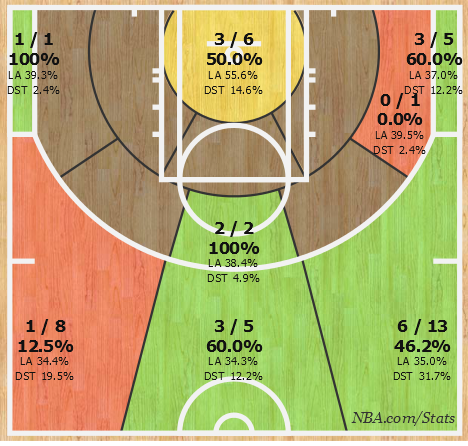For the second year in a row, there’s a rookie sensation out of Latvia that’s terrorizing the NBA with his sharpshooting.
Okay, maybe Davis Bertans isn’t on the same level as Kristaps Porzingis…yet, but the 24-year-old forward has made a solid impression lately.
His numbers are meager – 3.8 points, 1.4 rebounds, 0.4 assists and 0.6 blocks – but he’s been impactful off the box score in unexpected ways.
Back to his numbers real quick. If we give Bertans the benefit of the doubt, his per-36 numbers are 12.5 points and 4.2 rebounds a game, which is respectable for a rookie who was practically considered as a throw-in piece on draft night when the San Antonio Spurs and Indiana Pacers swapped George Hill for Kawhi Leonard.
Even overseas, Bertans never averaged more than 13.0 points per game in his international career, as a member of the Serbian club Partizan Belgrade.
So what exactly has gotten into the four-fingered assassin that had him setting back-to-back career-highs?
It’s a combination of several things not measured quantitatively, but there is evidence that pinpoints to when Bertans managed to flip the switch.
Bertans was assigned to the Austin Spurs as the NBA Development League kicked off its season, with the D-League Spurs facing the Oklahoma City Blue.
Strangely, Austin Spurs Head Coach Ken McDonald decided to start Bertans at the center position. Per Basketball Reference, Bertans has only played an estimated 9 percent of the season at center when in San Antonio. But shifting to the five spot allowed Austin to space the floor around point guard Dejounte Murray to maximize his ability to drive and kick.
The end result was Bertans scoring 22 points on 6-for-8 shooting from beyond the arc in the first half. Bertans’ scoreless second half was more of the defense making proper adjustments than bad shooting, but it’s something that NBA teams are still struggling to figure out.
Out of the seven field goals, Bertans had two shots that were unassisted: A putback layup off a Murray missed floater and a 3-pointer where Bertans faked driving into the lane, and pulled the crossover to step-back combination to nail a fadeaway three in Kaleb Tarczewski’s face.
That means 83 percent of his baskets came off assists in his game with Austin. For comparison, at the NBA level, 17 of his 19 field goals (.895) have come assisted this season.
So how is Bertans making all these field goals off assists? It starts with his ability to pick-and-pop on the perimeter. As shown in the video below, even as the play breaks down, Bertans manages to find open space off a screen to save his mistake.
[protected-iframe id=”e517e35c57e449be8e480d633af1d7f4-114320562-81586714″ info=”https://streamable.com/e/cpqu” width=”600″ height=”338″ frameborder=”0″ scrolling=”no”]Bertans accidentally picks off Manu Ginobili, who’s setting a screen on Ramon Sessions for Patty Mills to go left. Once Nicolas Batum steps up, Mills cuts back and runs Sessions through a pick-and-roll with Gasol. In a split second, Bertans recognizes that the entire offense and defense is sitting above the break, giving him a chance to slide into the corner, unnoticed by Frank Kaminsky, for the easy 3-pointer.
Beyond the pick-and-pop, Bertans has a huge knack for finding open spaces along the arc. Through 14 games, Bertans has made more 3-pointers (14) than total field goals attempted inside the 3-point line (9).
Smart shooters consistently finds their sweet spot on the floor, and Bertans has proven to be the king of abusing the nylon from the strong side, as the forward is shooting 11 percent above league average from the right wing. The way he finds angles and lanes to flash to his spot is practically an art.
[protected-iframe id=”01f9f7ff389ac7494bf3102ed3a9bf86-114320562-81586714″ info=”https://streamable.com/e/xyxi” width=”600″ height=”338″ frameborder=”0″ scrolling=”no”]Having Bertans on the low post with Danny Green in the corner defeats the purpose of floor spacing. As LaMarcus Aldridge sets the screen for Tony Parker, Amir Johnson helps Avery Bradley prevent any attempt of an easy layup for Parker. Horford doesn’t concern himself with Bertans sprinting to the wing because he’s helping defend Aldridge on the pick-and-pop from the top of the key. For some reason, Bradley gives up on defending Parker, which leaves him and Horford double-teaming Aldridge. By the time Horford recognizes his mistake, Bertans is on his toes for the open 3-pointer.
That same play a few weeks ago would’ve resulted in Bertans making an unnecessary extra pass and a failed possession. But against the Celtics on Friday afternoon? Parker, Green and Kawhi Leonard were already getting back on defense with the shot still in midair.
It happened again in the second half, as Bertans and Manu Ginobili would run a jumbled pick-and-pop to free Bertans for a contested 3-pointer over the 6-foot-4 Marcus Smart.
[protected-iframe id=”f0f77a3e17e64827a8beb4c361df3f15-114320562-81586714″ info=”https://streamable.com/e/rf6n” width=”600″ height=”338″ frameborder=”0″ scrolling=”no”]Even though Smart defended the play well, the height advantage allowed Bertans enough of a window to nail the jumper. But Smart is just one of the few to actually contest the Latvian’s shots.
Every tracking statistic shows that Bertans is the epitome of a catch-and-shoot player.
According to NBA stats, only 78 percent of Bertans’ field goal attempts are classified as a catch-and-shoot opportunity. Yet 95 percent of his field goal attempts come when he holds the ball for less than two seconds, and 88 percent of those attempts come without a dribble. And teams still haven’t adjusted to his shooting ability, with Bertans attempting 88 percent of his field goals as being either “open” (no defender within 4 to 6 feet) or “wide open” (no defender within 6 or more feet).
Even though Bertans has been given more minutes in the wake of Dewayne Dedmon’s injury, the trend should continue once the athletic center returns.
Out of the Spurs best 3-man lineups that have played at least 15 minutes or more together, Bertans finds himself in three of the top-5, with an average offensive rating of 149.7.
If you’re worried about defense, those same three lineups have a defensive rating of 102.2, right on par with the league average. But that number is inflated thanks in part to the trio of Bertans-Green-Leonard having a defensive rating of 115, which is probably an aberration since that triad contains arguably the Spurs two best defenders.
His assignment to Austin was on par with the typical ‘Spurs way’ of letting players get some practice and play time to keep them in game shape. But with his early struggles, it also helped Bertans ease any trepidation and build confidence in his game once called upon. And as long as he keeps making plays like this, his spot in the rotation will only continue to increase.
[youtube https://www.youtube.com/watch?v=-V7xGmPe0A0&w=560&h=315]Add The Sports Daily to your Google News Feed!


